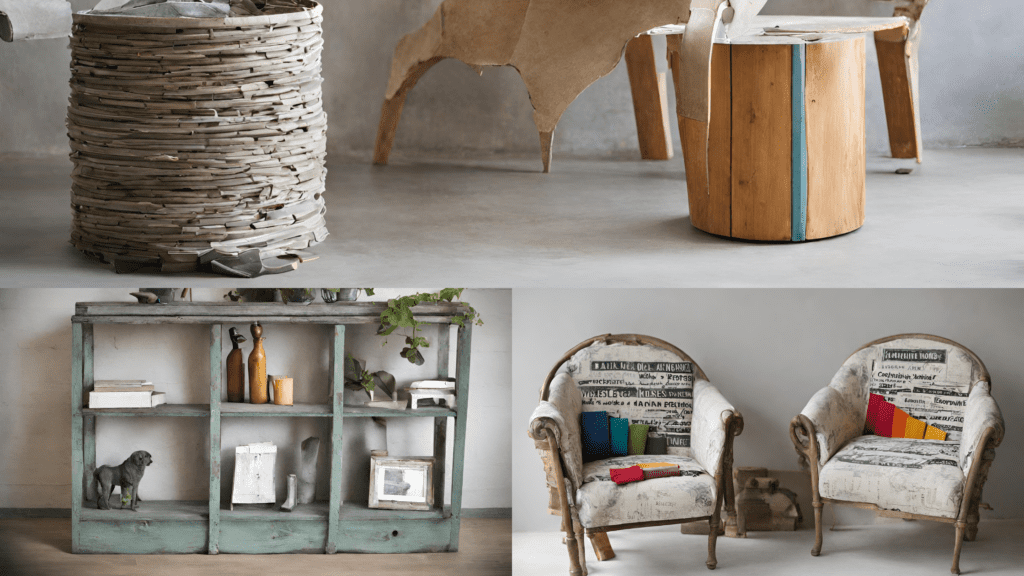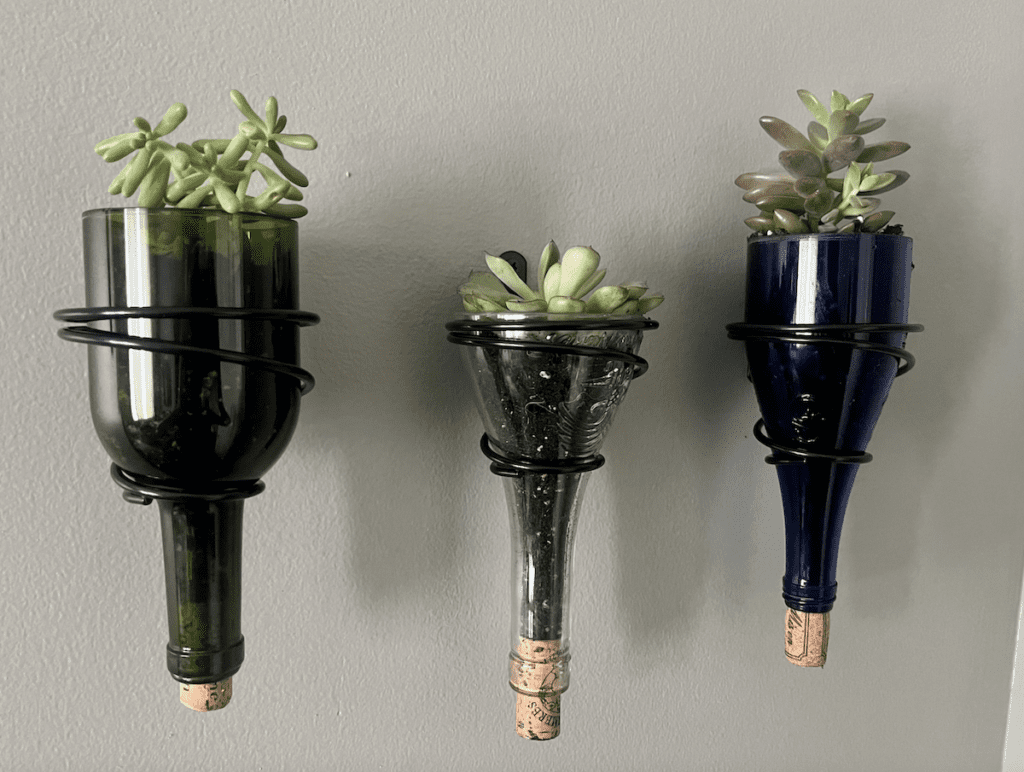At its core, upcycled products are a creative and eco-friendly means of reusing materials or items to grant them a fresh lease of life, elevating their value.
Unlike recycling, where materials are broken down to their raw form before being reprocessed into a new product, upcycling focuses on transforming an item without degrading its quality.
It’s about taking something old, worn, or discarded and turning it into something of higher value or purpose.
Upcycled vs Recycled
To better understand upcycling, it’s essential to distinguish it from recycling:
Recycling
Recycling involves breaking down used materials into their base components (like plastic bottles into plastic pellets) and then using those components to create new products.
While recycling reduces waste and conserves resources, it often requires a significant amount of energy and may result in a lower-quality product.
Upcycling
Upcycling, on the other hand, takes existing materials or products and transforms them into something better, often with a completely different function.
The primary goal of upcycling is to maximize the potential of discarded items while minimizing waste.
The Benefits of Upcycling
Environmental Impact
Upcycling reduces the need for new resources and minimizes waste. It helps combat the growing problem of landfill overflow and lessens the extraction of raw materials, which can be harmful to the environment.
Energy Efficiency
Upcycling typically requires less energy compared to recycling, where materials are processed and reformed. This energy efficiency contributes to a lower carbon footprint and helps combat climate instabilities.

Creativity and Innovation
Upcycling encourages creative thinking and innovation. It challenges individuals to look at everyday items from a different perspective, fostering a culture of ingenuity and resourcefulness.
Unique and Personalized Products
Upcycled items are often one-of-a-kind, offering a unique and personalized touch to your home or wardrobe. They tell a story and carry a history, making them all the more valuable.
Economic Benefits
Upcycling can provide economic opportunities, both for individuals and businesses. Artisans and entrepreneurs can turn their passion for upcycling into a source of income, promoting local, sustainable industries.
Notable Examples of Upcycling
Tire Furniture
Old tires can be transformed into stylish and durable furniture pieces, such as ottomans, chairs, and coffee tables. This not only gives tires a second life but also reduces the need for new materials.
Vintage Clothing
Upcycling vintage clothing is a popular trend. Designers and hobbyists repurpose old garments, combining them with modern elements to create unique, fashionable clothing items.
Pallet Wood Decor
Pallets, often discarded after use, can be upcycled into various home decor items like rustic picture frames, wall art, and even garden furniture.
Glass Bottle Planters

Empty glass bottles can be upcycled into beautiful planters, adding charm and character to your home while reducing waste.
Musical Instrument Upcycling
Old musical instruments, like guitars or pianos, can be turned into shelves, tables, or other functional decor pieces.
Challenges and Considerations
While upcycling is a fantastic way to contribute to sustainability and creativity, there are a few challenges to keep in mind:
- Quality Control: The quality of upcycled products can vary, depending on the skills and materials used. Ensuring a consistent standard can be challenging.
- Sourcing Materials: Finding suitable materials for upcycling can be time-consuming. Many upcyclers rely on thrift stores, garage sales, or donations to acquire items to repurpose.
- Market Acceptance: Not everyone is aware of or open to upcycled products. Raising awareness and educating consumers about the benefits of upcycling is essential for its growth.
Upcycling is not just a trendy buzzword; it’s a meaningful and practical approach to sustainability. By breathing new life into old and discarded items, we reduce waste, conserve resources, and inspire creative thinking.
Upcycling offers countless possibilities for individuals and businesses to make a positive impact on the environment while enjoying the fruits of their creativity.
As we move toward a more sustainable future, upcycling plays a crucial role in redefining our relationship with the items we use, discard, and transform.
The next time you come across an old item that seems past its prime, consider the art of upcycling, and watch it transform into something new and valuable before your eyes.
Frequently Asked Questions About Upcycling
What is the difference between upcycling and recycling?
Recycling breaks materials down into raw components, which are then reprocessed into new products. This often requires significant energy and may result in lower-quality materials. Upcycling, on the other hand, transforms existing items into something of higher value without breaking them down, often giving them a completely new purpose.
Why is upcycling important for the environment?
Upcycling reduces the amount of waste sent to landfills, conserves natural resources, and lowers demand for raw material extraction. It also saves energy compared to recycling, leading to a smaller carbon footprint.
Can upcycling save money?
Yes. Upcycling allows individuals to repurpose items they already own instead of buying new ones. It also provides opportunities for artisans and small businesses to sell unique products, supporting local economies.
What are some easy upcycling ideas for beginners?
Popular beginner projects include turning glass jars into planters, repurposing old clothes into reusable shopping bags, converting wooden pallets into furniture, or transforming tires into garden seats or tables.
Are upcycled products durable?
Durability depends on the materials used and the skill of the creator. Many upcycled items, such as pallet wood furniture or cast-iron repurposed pieces, can be just as strong and long-lasting as new products.
What are the challenges of upcycling?
Some challenges include sourcing suitable materials, ensuring consistent product quality, and overcoming consumer perceptions. Not everyone is familiar with the concept, so raising awareness about its value is essential.
How does upcycling encourage creativity?
Upcycling requires reimagining everyday items in new ways. It fosters innovation, resourcefulness, and problem-solving by challenging people to see potential in what might otherwise be discarded.
Can businesses benefit from upcycling?
Absolutely. Many brands and small businesses now focus on creating upcycled products, from fashion to furniture. This not only reduces waste but also appeals to eco-conscious consumers looking for sustainable and unique alternatives.
Is upcycling just a trend or a long-term solution?
Upcycling is more than a trend. It represents a sustainable shift in how we think about consumption, waste, and value. As awareness grows, upcycling is expected to play a lasting role in creating a circular economy.
Frequently Asked Questions About Upcycling
What makes upcycling different from recycling?
Recycling breaks items down into raw materials before creating something new, often using a lot of energy and producing lower-quality materials. Upcycling instead transforms an existing item into something of higher value without breaking it down, often giving it a completely new function.
Why is upcycling good for the environment?
Upcycling reduces landfill waste, conserves natural resources, and avoids the energy-intensive process of recycling. By reusing materials, it lowers the demand for raw material extraction and helps cut carbon emissions.
Can I start upcycling at home without special skills?
Yes. Beginners often start small by repurposing glass jars into planters, turning old clothes into reusable bags, or using wooden pallets for shelves or garden furniture. Many projects require only basic tools and creativity.
Are upcycled products reliable and long-lasting?
They can be. Durability depends on the materials used and the maker’s skill. For example, pallet furniture or upcycled cast-iron pieces can be just as sturdy as store-bought items when made carefully.
Is upcycling just a passing trend?
No. Upcycling reflects a broader cultural and economic shift toward sustainability and circular design. As more people and businesses embrace eco-friendly practices, upcycling is becoming a long-term solution rather than a short-lived trend.








